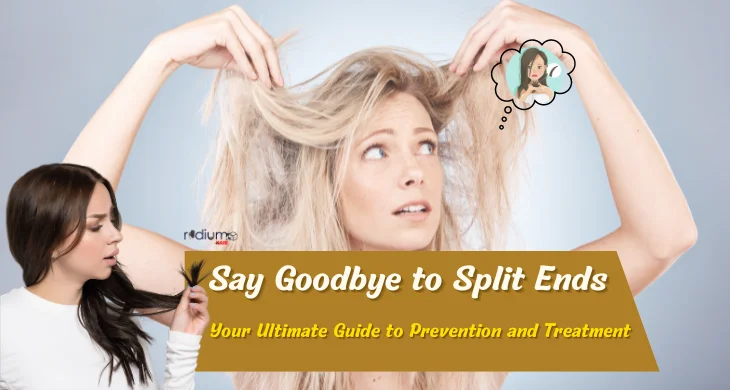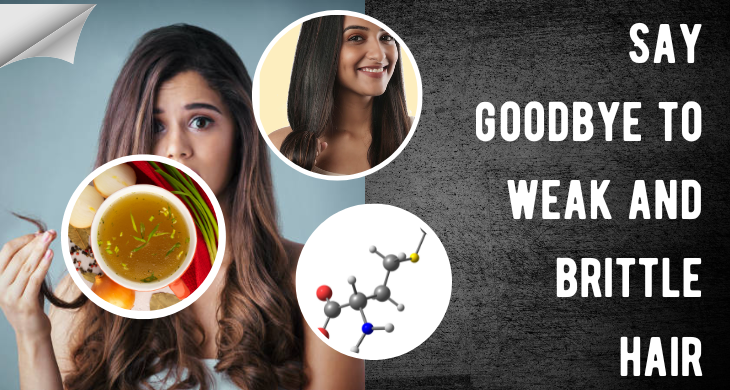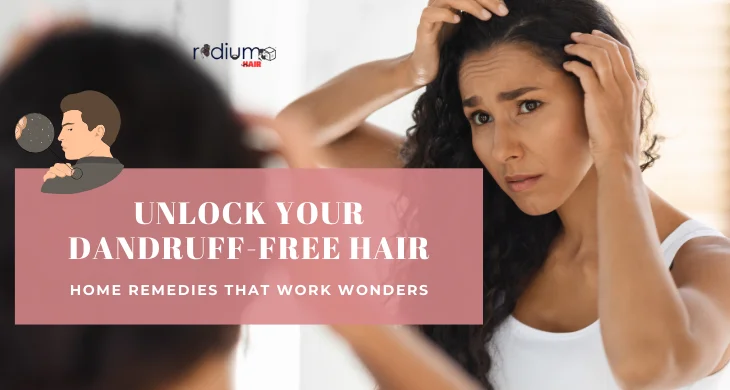Dealing with split ends? You’re not alone. Whether it’s from heat styling, overusing hair products, or frequent hair coloring, split ends can be a common hair woe. But fear not! This comprehensive guide will help you understand what split ends are, their types, causes, and most importantly, how to treat and prevent them.
Understanding Split Ends
Split ends are a common hair woe that many of us face. They appear when the cuticle, your hair’s exterior layer of protection, begins to deteriorate, splitting and fraying the inner layers. This results in those dreaded split ends that make your hair look dull and unhealthy.
To check if you have split ends, take a close look at the ends of your hair strands. If you notice any ragged or uneven tips, or if your hair tends to tangle easily, these are telltale signs of split ends. Another way to check is by gently running your fingers down a strand of hair from root to tip. If you feel any rough patches or see the hair strand splitting into two or more pieces, you’ve got split ends.
Regular visits to your hairstylist are essential for identifying and treating split ends. Your stylist can trim away the damaged ends, preventing the split from traveling further up the hair shaft. This not only improves the appearance of your hair but also promotes healthier growth.
Don’t ignore split ends; they won’t repair themselves. Addressing them early with proper care and maintenance can save you from more extensive damage and keep your locks looking their best.
Types of Split Ends
It might surprise you, but there are 16 distinct types of split ends! Each type, from the classic split to feather splits, presents its own set of characteristics. For instance, traditional splits form a “Y” shape at the end of the hair, while feather splits resemble the frayed edges of a feather. Recognizing these different types can be crucial for effective treatment. By understanding the specific type of split end you have, you can choose the most appropriate remedies and prevention methods to keep your hair healthy and split-end free.
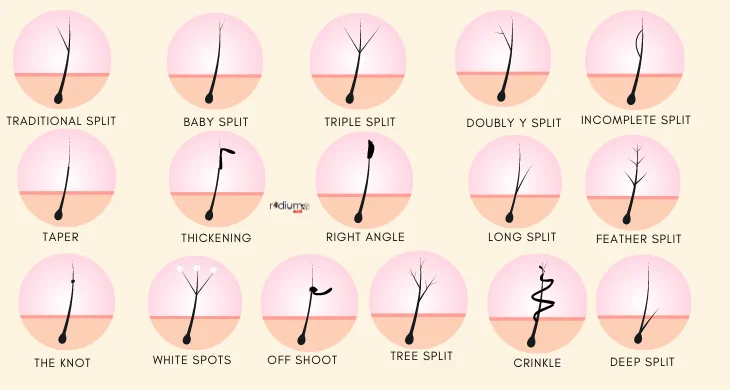
- Traditional Split: This is the most familiar split end type, where the hair divides into two strands, forming a shape that resembles the letter “Y.” It’s a clear sign of hair damage and can occur due to various factors like heat styling, chemical treatments, or rough handling.
- Baby Split: Considered a precursor to traditional splits, the hair shaft begins to separate, but it hasn’t split completely yet. It’s an early warning sign that your hair is becoming damaged and needs attention.
- Triple Split: A more severe stage of hair damage, the hair splits into three strands, indicating advanced weakening and breakage. It’s essential to address this type promptly to prevent further damage.
- Doubly Y Split: This is a complex split where the hair divides into two strands, and one of those branches off again, forming a “Y” shape with an extra split. It’s a sign of significant hair damage.
- Incomplete Split: In this stage, the hair shaft weakens at a specific point but hasn’t fully split yet. It’s an early stage of damage that requires immediate care to prevent further splitting.
- Long Split: The hair shaft starts to separate at a specific point, making it longer than other types of splits. It’s a sign that your hair is becoming damaged and needs attention.
- Deep Split: An advanced stage of the traditional split, the “Y” shape starts higher up on the hair shaft, indicating deeper damage.
- Taper: This occurs when the cuticle peels away, typically due to chemical damage, resulting in a tapered appearance at the end of the hair.
- Thickening: While the ends of the hair remain intact, the texture of the hair changes, indicating early-stage damage.
- White Spots: Severe chemical burns can cause these visible white spots on the hair shaft, indicating significant damage.
- Right Angle: The hair starts to bend at an angle, indicating structural weakness and potential breakage.
- Off Shoot: After splitting, the hair shaft appears to “thicken” and bond back together, showing signs of repair but still vulnerable to further damage.
- Crinkle: Excessive heat styling or chemical treatments can cause the hair to appear wrinkled, indicating severe damage.
- Tree Split: Multiple splits occur along the shaft, resembling a tree’s branches, indicating extensive damage and breakage.
- Feather Split: Resembling a feather, this type shows multiple splits along one side of the hair shaft, indicating significant damage.
- The Knot: Common among curly hair, this isn’t a split end but a knot that can lead to more tangles and breakage, requiring careful detangling to avoid further damage.
Common Causes of Split Ends
Several factors contribute to split ends:
- Heat Damage: Excessive use of curling, straightening, or blow-drying tools can lead to split ends. These tools expose your hair to high temperatures, which can weaken the hair shaft and cause it to break. Over time, repeated heat styling can result in dry, brittle hair that is more prone to splitting. To minimize heat damage, it’s essential to use these tools sparingly and always apply a heat protectant product before styling. This creates a barrier between your hair and the heat, reducing the risk of damage and keeping your locks healthy.
- Chemical Damage: Chemical treatments like perms, bleaching, or straightening can severely damage your hair and lead to split ends. These treatments alter the structure of your hair, making it more susceptible to breakage and damage. The hair may become dry and brittle as a result of the chemicals employed stripping it of its natural oils. It’s crucial to consult with a professional hairstylist before undergoing any chemical treatments and to follow their recommendations for aftercare to minimize damage.
- Lack of Protection: Skipping heat protectant products leaves your hair vulnerable to damage from heat styling tools. These products create a protective barrier on your hair, reducing the impact of high temperatures and helping to maintain its health and integrity. Incorporating a heat protectant into your styling routine is a simple yet effective way to safeguard your hair from damage and prevent split ends.
- Hair Care Practices: Rough brushing, overwashing, and sleeping with wet hair can contribute to split ends. Rough brushing can cause friction and breakage, while overwashing can strip your hair of its natural oils, making it dry and brittle. Sleeping with wet hair increases the likelihood of breaking and weakens the hair shaft. To prevent split ends, it’s essential to handle your hair gently, wash it no more than necessary, and avoid sleeping with wet hair. Adopting a gentle hair care routine can help keep your locks healthy and split end-free.
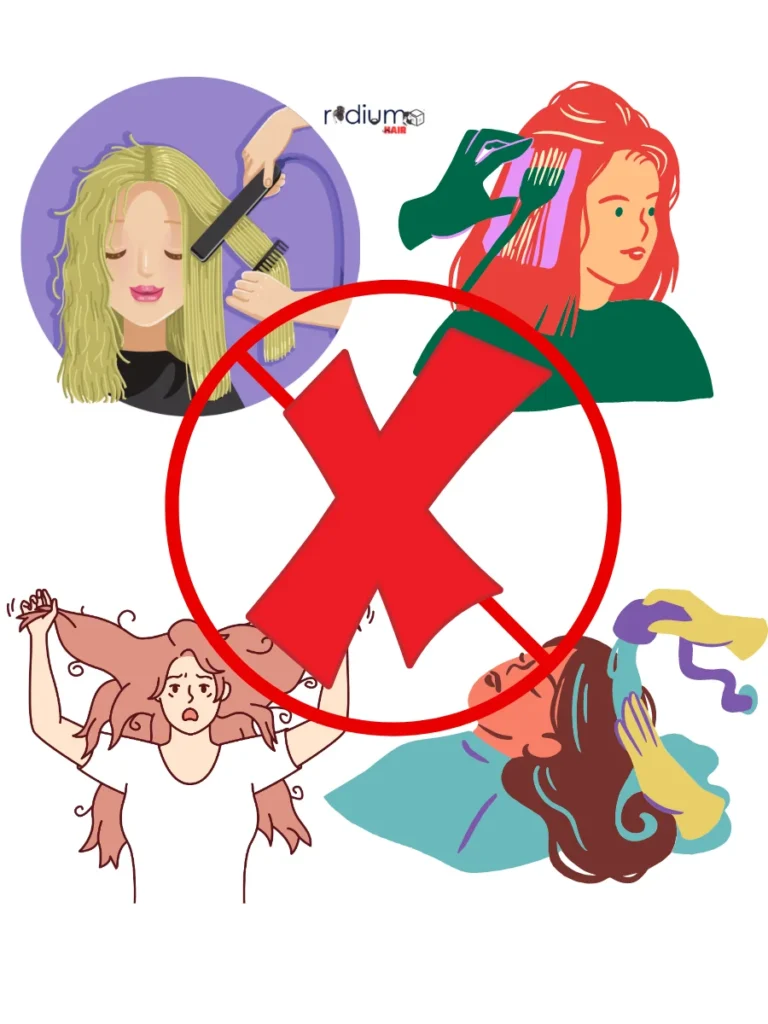
Effective Treatment Options
While preventing split ends is ideal, there are ways to treat them:
- Regular Trims: Scheduling haircuts every six weeks is a proactive approach to preventing split ends. By removing the damaged tips regularly, you can maintain the health and vitality of your hair. Even if you’re trying to grow out your hair, these regular trims won’t hinder your growth but rather promote healthier hair growth. It’s a small investment of time that pays off in the long run by keeping your locks looking fresh and free from split ends.
- Haircut Techniques: Choosing the right haircut techniques can help manage damaged ends effectively. Opting for layers or feathering can help blend and soften the appearance of split ends, making them less noticeable. These techniques can also add volume and texture to your hair, giving it a healthier and more vibrant look. Consult with your hairstylist to determine which haircut techniques will best suit your hair type and address your specific concerns.
- Deep Conditioning: Revitalizing your locks with deep conditioning treatments can work wonders for damaged hair. Whether you opt for salon treatments or DIY masks, these intensive conditioning sessions help nourish and hydrate your hair, restoring its natural shine and softness. Regular deep conditioning can strengthen your hair, making it more resilient to damage and reducing the occurrence of split ends. Look for treatments rich in natural oils and proteins to provide your hair with the nutrients it needs to thrive.
- Shampoo Selection: Choosing the right shampoo is crucial for maintaining healthy hair and preventing split ends. Opt for moisturizing, sulfate-free shampoos that gently cleanse your hair without stripping it of its natural oils. Sulfates can be harsh on your hair, leading to dryness and damage over time. By selecting a nourishing shampoo, you can keep your hair hydrated and healthy, reducing the risk of split ends. Remember to read the labels and look for ingredients that will benefit your hair, such as argan oil, coconut oil, or keratin. Your hair will love the additional attention!
Preventing Split Ends
Prevention is key! Here’s how to keep split ends at bay:
- Limit Heat Styling: Excessive heat styling can damage your hair, leading to split ends and breakage. To minimize this damage, opt for air drying your hair whenever possible instead of using blow dryers, curling irons, or straighteners. If you need to style your hair, consider using foam rollers as a heat-free alternative. Foam rollers can give you beautiful curls or waves without the damaging effects of heat. By reducing your reliance on hot tools, you can help your hair retain its natural moisture and prevent split ends from forming.
- Regular Haircuts: Keeping up with regular haircuts is essential for maintaining healthy locks and preventing split ends. Schedule trims every six to eight weeks to remove any damaged ends and keep your hair looking its best. Even if you’re trying to grow out your hair, these regular trims are crucial for preventing split ends from traveling up the hair shaft and causing more damage. Your hair will feel lighter, look fresher, and be less prone to breakage with consistent maintenance.
- Home Remedies: Natural treatments can be a fantastic way to nourish and repair damaged hair. Incorporating DIY hair masks using ingredients like avocado or coconut oil can provide deep conditioning benefits that commercial products may not offer. Avocado is rich in vitamins and fatty acids that can hydrate and strengthen your hair, while coconut oil helps to seal in moisture and protect against damage. These simple yet effective home remedies can help revitalize your locks, making them more resilient to split ends and breakage.
- Hair Care Habits: Your daily hair care habits can significantly impact the health and appearance of your hair. Using silk or satin pillowcases can help reduce friction and prevent tangles, leading to less breakage and fewer split ends. Protecting your hair from the sun’s harmful UV rays with hats or scarves can also help maintain its health and prevent color fading. Additionally, staying hydrated by drinking plenty of water supports overall hair health, keeping your strands moisturized from the inside out. By incorporating these habits into your daily routine, you can promote stronger, healthier hair and reduce the risk of split ends.
Conclusion
Split ends are a common hair concern, but with proper care and treatment, you can restore your hair’s health and prevent future damage. By understanding the causes and adopting healthy hair care habits, you can enjoy luscious, split-end-free locks!
Frequently Asked Questions
Q: What are split ends?
A: Split ends occur when the tips of your hair shaft split and fray, resulting in a ragged appearance.
Q: How can I identify split ends?
A: You can identify split ends by examining a strand of your hair. If it looks ragged or tangles easily, you likely have split ends.
Q: What causes split ends?
A: Common causes include heat damage, chemical treatments, lack of protection, and rough hair care practices.
Q: How can I treat split ends?
A: Treatments include regular trims, deep conditioning, using moisturizing shampoos, and applying DIY hair masks.
Q: How can I prevent split ends?
A: Prevent split ends by limiting heat styling, scheduling regular haircuts, using protective treatments, and adopting healthy hair care habits.

